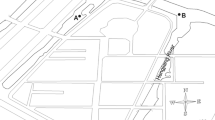Abstract
Natural biofilms were simultaneously grown on glass, plexi-glass, glass fiber and activated carbon fiber for 60 days in a shallow Lake in Haihe basin. Biofilm production and abundance of algae were influenced by the substratum. Magnitude of the substratum effect was glass < plexi-glass < glass fiber < activated carbon fiber. The bacteria communities in biofilms of nature substrata were similar with the biofilms on plexi-glass and glass fiber after 60-day growing, as well as the ones on activated carbon fiber after 14-day growing. On basis of algological and bacteriological investigations, as well as literature data, the activated carbon fiber substratum is recommended for biomonitoring the lake in Haihe basin.







Similar content being viewed by others
References
Cattaneo A, Amireault MC (1992) How artificial are artificial substrata for periphyton? J North Am Benthol Soc 11:244–256
Dorigo U, Leboulanger C, Bérard A, Bouchez A, Humbert JF, Montuelle B (2008) Lotic biofilm community structure and pesticide tolerance along a contamination gradient in a vineyard area. Aquat Microb Ecol 50:91–102
Hu HJ, Wei YX (2006) The freshwater algae of China: systematics, taxonomy and ecology. Science Press, Beijing
Huang TL, Cong HB, He WJ (2002) Determination method of aquatic algae chlorophyll, China: CN200410073542.8 (in chinese)
Ishida CK, Arnon S, Peterson CG, Kelly JJ, Gray KA (2008) Influence of algal community structure on denitrification rates in periphyton cultivated on artificial substrata. Microb Ecol 56:140–152
Kelly MG (1998) Use of trophic diatom index to monitor eutrophication in rivers. Water Res 32:236–242
Kralj K, Plenkovi-Moraj A, Gligora M, Primc-Habdija B, ipo L (2006) Structure of periphytic community on artificial substrata: influence of depth, slide orientation and colonization time in karstic Lake Visova ko, Croatia. Hydrobiologia 560:249–258
Kropfl K, Vladár P, Szabó K, Acs E, Borsodi AK, Szikora S, Caroli S, Záray G (2006) Chemical and biological characterisation of biofilms formed on different substrata in Tisza river (Hungary). Environ Pollut 144:626–631
Lane CM, Taffs KH, Corfield JL (2003) A comparison of diatom community structure on natural and artificial substrata. Hydrobiologia 493:65–79
Liu JL, Zeng WH, Zeng Y (2008) Optimal operation of urban water system in Haihe river basin. Science Press, Beijing
Morin S, Duong TT, Herlory O, Feurtet-Mazel A, Coste M (2008) Cadmium toxicity and bioaccumulation in freshwater biofilms. Arch Environ Contam Toxicol 54:173–186
Mosisich TD, Bunn SE, Davies PM (2001) The relative importance of shading and nutrients on algal production in subtropical streams. Freshw Biol 46:1269–1278
Ricart M, Barcelo D, Geiszinger A, Guasch H, Sabater S, Villagrasa M (2009) Effects of low concentrations of the phenylurea herbicide diuron on biofilm algae and bacteria. Chemosphere 76:1392–1401
Sabater S, Gregory SV, Sedell JR (1998) Community dynamics and metabolism of benthic algae colonizing wood and rock substrata in a forest stream. J Phycol 34:561–567
Sabater S, Guasch H, Ricart M, Romaní A, Vidal G, Klünder C, Schmitt-Jansen M (2007) Monitoring the effect of chemicals on biological communities. The biofilm as an interface. Anal Bioanal Chem 387:1425–1434
Timothy TH, Jennifer LT, John JK, Emma JR (2010) Seasonal variation in nutrient limitation of microbial biofilms colonizing organic and inorganic substrata in streams. Hydrobiologia 639:331–345
Tlili A, Dorigo U, Montuelle B, Margoum C, Carluer N, Gouy V, Bouchez A, Bérard A (2008) Responses of chronically contaminated biofilms to short pulses of diuron: an experimental study simulating flooding events in a small river. Aquat Toxicol 87:252–263
Webster JR, Meyer JL (1997) Organic matter budgets for streams: a synthesis. J North Am Benthol Soc 16:141–161
Weitzel RL, Sanocki SL, Holecek H (1979) Sample replication of periphyton collected from artificial substrates. In: Weitzel RL (ed) Methods and measurements of periphyton communities: a review, pp 90–115
Xu H, Min GS, Choi JK, Kim SJ, Jung JH, Lim BJ (2009) An approach to analyses of periphytic ciliate communities for monitoring water quality using a modified artificial substrate in Korean coastal waters. J Mar Biol Assoc UK 89:669–679
Acknowledgment
This work was supported by the Evolution of Physical Process and Protection Technology of Environmental Flow for Haihe River Basin (2011ZX07203-006) and the National Water Pollution Control Major Project of China (No. 2008ZX7290-009).
Author information
Authors and Affiliations
Corresponding author
Rights and permissions
About this article
Cite this article
Wang, X., Ma, M. & Liu, J. Biological Characteristics of Biofilms Formed on Different Substrata in a Shallow Lake in Haihe Basin (China). Bull Environ Contam Toxicol 90, 414–420 (2013). https://doi.org/10.1007/s00128-012-0908-0
Received:
Accepted:
Published:
Issue Date:
DOI: https://doi.org/10.1007/s00128-012-0908-0




